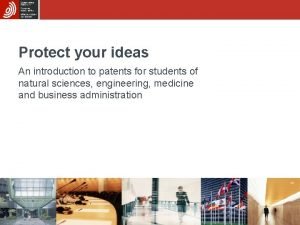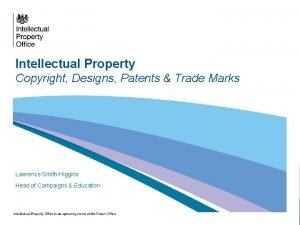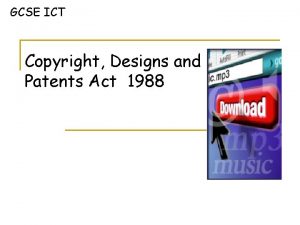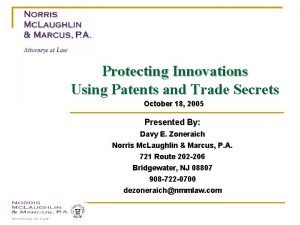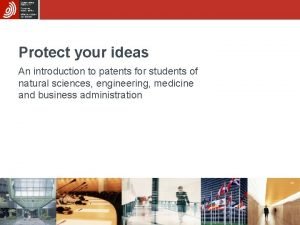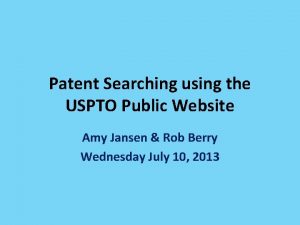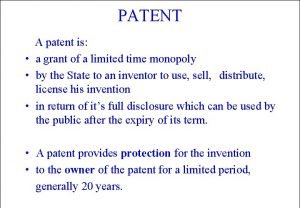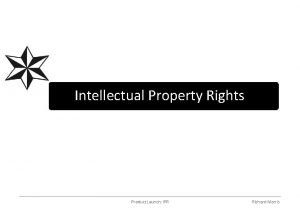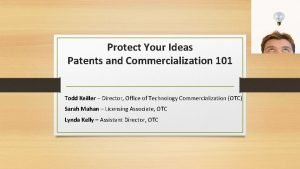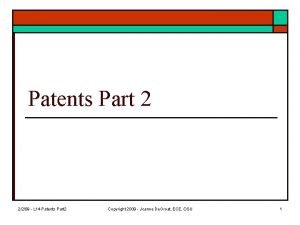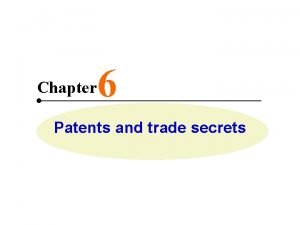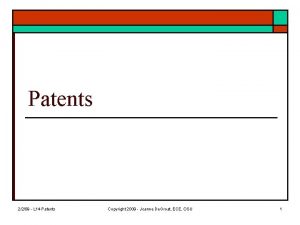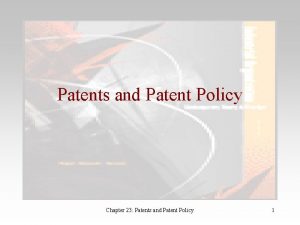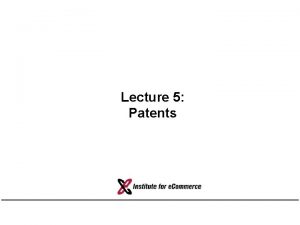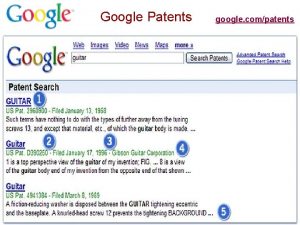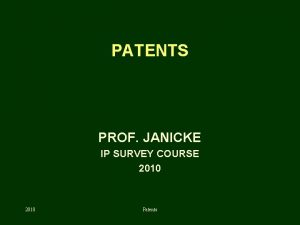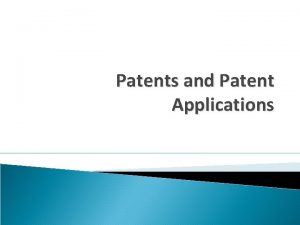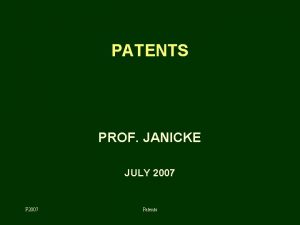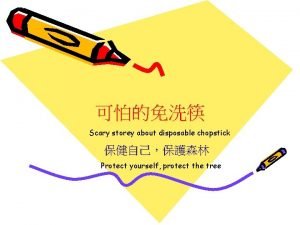Protect your ideas An introduction to patents for






















- Slides: 22

Protect your ideas An introduction to patents for students of natural sciences, engineering, medicine and business administration

Overview of intellectual property Legal right What for? Patents New inventions Application and examination Copyright Original creative or artistic forms Exists automatically Trade marks Distinctive identification of products or services Use and/or registration Registered designs External appearance Registration* Trade secrets Valuable information not known to the public Reasonable efforts to keep secret Core module 1 Protect your ideas How? 2/43

Some IP found in a mobile phone Trade marks: • Made by "Nokia" • Product "N 95" • Software "Symbian", "Java" Patents: • Data-processing methods • Semiconductor circuits • Chemical compounds • … Trade secrets: ? Copyrights: • Software code • Instruction manual • Ringtone • … Designs (some of them registered): • Form of overall phone • Arrangement of buttons in oval shape • Three-dimensional wave form of buttons • … Core module 1 Protect your ideas © Nokia 3/43

Optional The first account of a "patent system" In the ancient Greek city of Sybaris (destroyed in 510 BC), leaders decreed: "If a cook invents a delicious new dish, no other cook is to be permitted to prepare that dish for one year. During this time, only the inventor shall reap the commercial profits from his dish. This will motivate others to work hard and compete in such inventions. " Core module 1 Protect your ideas 4/43

The patent system Senate of Venice, 1474: "Any person in this city who makes any new and ingenious contrivance, not made heretofore in our dominion, shall, as soon as it is perfected so that it can be used and exercised, give notice of the same to our State Judicial Office, it being forbidden up to 10 years for any other person in any territory of ours to make a contrivance in the form and resemblance thereof". Today: New to the world (Europe); up to 20 years of protection Incentive to innovate Incentive to share knowledge Core module 1 Protect your ideas (grant protection) (publish the invention's details) 5/43

Optional An early English patent issued in 1617 Core module 1 Protect your ideas 6/43

Optional GB patent No. 1769 -913: Watt's improved steam engine Core module 1 Protect your ideas 7/43

The "social contract" implicit in the patent system Get exclusivity Reveal invention … so that others can learn from it and improve upon it! Core module 1 Protect your ideas 8/43

Rights conferred by the patent • Prevent others from making, using, offering for sale, selling or importing infringing products in the country where the patent was granted • Sell these rights or conclude licensing contracts • For up to 20 years from the date of filing of the patent application The patent does not grant the right to use the invention! rch !! a se ble! t ten nsa a A p dispe n is i Core module 1 Protect your ideas 9/43

What does a patent look like? • Bibliographic information – Inventor, proprietor, date of filing, technology class, etc. • Abstract – Around 150 words as a search aid for other patent applications • Description – Summary of prior art (i. e. the technology known to exist) – The problem that the invention is supposed to solve – An explanation and at least one way of carrying out the invention • Claims – Define the extent of patent protection • Drawings – Illustrate the claims and description Core module 1 Protect your ideas 10/43

Core module 1 Protect your ideas 11/43

What can be patented at the European Patent Office? Inventions that are… • new to the world (no previous public notice) • inventive (i. e. not an "obvious" solution) • susceptible of industrial application NOT: • Mere ideas not reduced to practice • Software as such • (but algorithms that achieve technical results) • Business methods • Medical therapies, plant varieties, etc. • … See Articles 52 and 53 EPC in http: //www. epo. org/patents/law/legal-texts/epc. html Core module 1 Protect your ideas 12/43

What not to do when considering filing a patent application • No publication prior to filing e. g. no article, press release, conference presentation/poster/proceedings or blog entry • No sale of products incorporating the invention prior to filing N A D • No lecture or presentation prior to filing except under a non-disclosure agreement (NDA) • Seek professional advice soon! • File before others do! Core module 1 Protect your ideas 13/43

Where to apply for a patent • National patent offices – National patent valid only in the country where it is granted – Non-residents can also apply for a patent – One year of "priority" for subsequent applications • European Patent Office – A European patent is equivalent to national patents in the countries where it is granted (the applicant chooses the countries) • Via the Patent Cooperation Treaty – Just one application for up to 141 countries – After the initial application phase, the international application leads to multiple national patent examination procedures – Decisions with cost implications can be delayed until 30 -31 months after filing (e. g. choice of countries to file in) • There is no such thing as an international patent! Core module 1 Protect your ideas 14/43

Optional The patent procedure at the EPO Application Search report Publication of application Publication of grant Opposition period expires 18 months Withdraw? Approx. 4 -5 years Core module 1 Protect your ideas 9 months 15/43

Cost of a national patent application: Germany Patent Invention attorney EUR 1 000 to EUR 4 000 Patent granted! Apply for Annual fees patent 4 5 Examination Year 3 EUR 60 EUR 350 EUR 70 EUR 90 Total: EUR 1 700 - EUR 5 100 (depending on complexity of patent and extent of applicant's preparation! Core module 1 Protect your ideas 16/43

Cost of a European patent up to grant Protection in (e. g. ): Germany United Kingdom France Italy Spain Switzerland EUR 3 000 translations* EUR 10 000 patent attorney fees* EUR 5 000 patent office fees* German patent European patent * Estimated cost. Actual cost depends very much on the specifics of the individual case. Core module 1 Protect your ideas 17/43

Advantages and disadvantages of patenting Advantages Disadvantages • Exclusivity enables investment and higher returns on investment • Reveals invention to competitors (after 18 months) • Strong, enforceable legal right • Can be expensive • Makes invention tradable (licensing) Core module 1 Protect your ideas • Patent enforceable only after grant (this can take 4 -5 years) 18/43

Alternatives to patenting Information disclosure (publishing) • Cheap • Prevents others from patenting the same invention • Does not offer exclusivity • Reveals the invention to competitors Secrecy (creating a trade secret) • Cheap (but there is the cost of maintaining secrecy) • Does not reveal the invention • No protection against reverseengineering/duplication of invention • Difficult to enforce • "Secrets" often leak quite fast Do nothing • No effort required Core module 1 Protect your ideas • Does not offer exclusivity • Competitors will often learn details 19/43

How patents are used • Protecting products and processes – Increasing turnover and profits – Attracting investors • Licensing • Cross-licensing • Blocking competitors • Building reputation • … • Not used Core module 1 Protect your ideas 20/43

Searching for patents can be easy. . . Free worldwide patent information is available at http: //ep. espacenet. com Core module 1 Protect your ideas 21/43

Find out how to search for patents! www. epo. org/wbt/pi-tour www. epo. org/patents/learning/e-learning. html Core module 1 Protect your ideas 22/43
 Stanley meyer patents pdf
Stanley meyer patents pdf Advantages and disadvantages of patents
Advantages and disadvantages of patents What is the copyright designs and patents act 1988
What is the copyright designs and patents act 1988 Copyright in ict
Copyright in ict Definition of trade secrets
Definition of trade secrets Advantages and disadvantages of patents
Advantages and disadvantages of patents Different types of patents
Different types of patents Patents are granted for a new
Patents are granted for a new Patents
Patents Out of the heart flows the issues of life
Out of the heart flows the issues of life Protect your dream
Protect your dream Protect your executives
Protect your executives Ideas have consequences bad ideas have victims
Ideas have consequences bad ideas have victims Que son las ideas complementarias
Que son las ideas complementarias Give us your hungry your tired your poor
Give us your hungry your tired your poor Kontinuitetshantering
Kontinuitetshantering Typiska drag för en novell
Typiska drag för en novell Nationell inriktning för artificiell intelligens
Nationell inriktning för artificiell intelligens Ekologiskt fotavtryck
Ekologiskt fotavtryck Varför kallas perioden 1918-1939 för mellankrigstiden
Varför kallas perioden 1918-1939 för mellankrigstiden En lathund för arbete med kontinuitetshantering
En lathund för arbete med kontinuitetshantering Personalliggare bygg undantag
Personalliggare bygg undantag Vilotidsbok
Vilotidsbok

